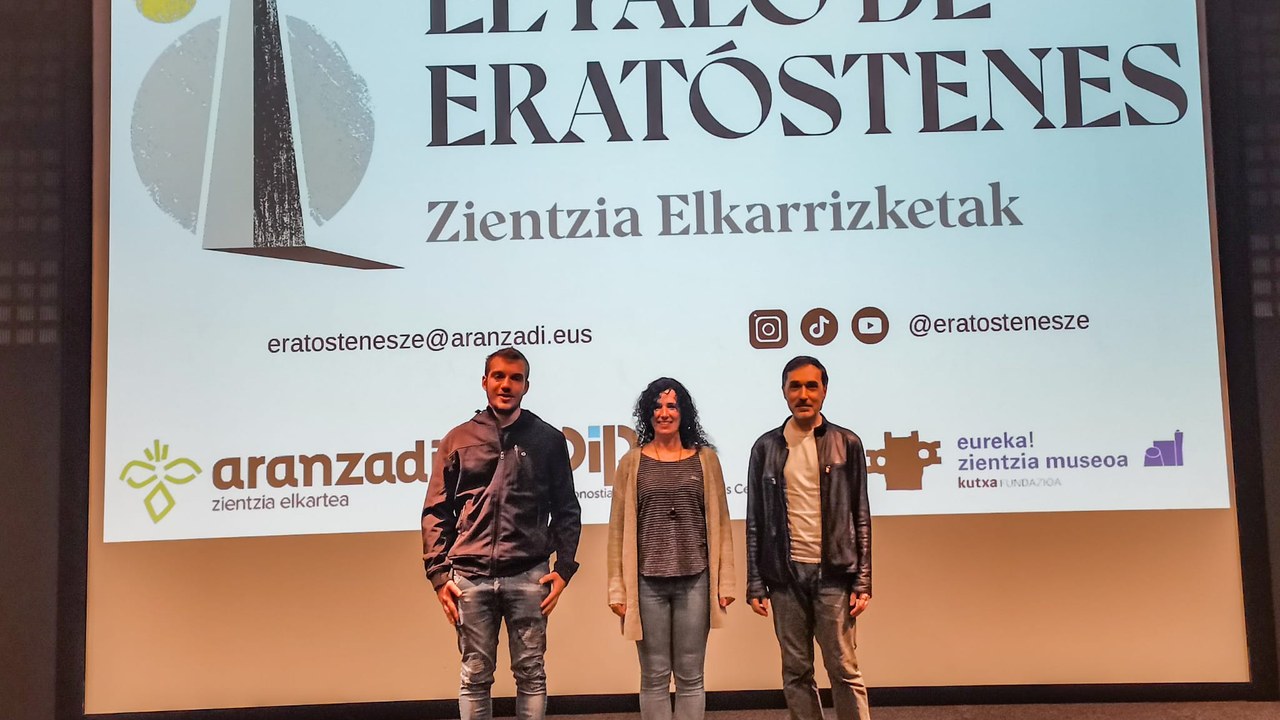DIPC collaborates in the new cycle of conferences on astronomy of Aranzadi
Bringing astronomy closer to the public is the main objective of the lecture series El Palo de Eratóstenes - Zientzia Elkarrizketak that will offer a meeting point for the scientific community and the public every month at Eureka! Zientzia Museoa.

On June 13, Aranzadi Science Society will begin the series of lectures El Palo de Eratóstenes – Zientzia Elkarrizketak in collaboration with Eureka! Sience Museum and Donostia International Physics Center (DIPC). The series are named after the scientist Eratóstenes that 2000 years ago measured the Earth circumference using the shadow cast by a stick. This is a science dissemination program focused on astronomy, astrophyisics, cosmology and other close science fields.
Virginia García and Eduardo Zubia, members of the astronomy Department of the Aranzadi Science Society, are in charge of the project that will also count on the collaboration of researchers that will spread their work. “The main goal of this public program is to get the forefront of the research in this field close to people in a truthful and understandable way”.
Sessions
These dissemination sessions are open and free for everyone and will have a duration of 90 min. The sessions will include a brief description of the next month´s visible sky. In addition, the most significant astronomic objects will be presented analyzing pictures which have been taken by citizen scientists. Finally, the most important news in astronomy and astronautics will be discussed, including those in the media that require deeper explanation, as well as those that have passed unnoticed instead their importance.
Researchers will also be invited to talk about their own work.
Sessions will be streamed alive and will, later, be available in youtube for their visualization.
Guided tours will periodically be organized to visit research centers such as the Javalambre Astronomical Observatory (Teruel) or the Canfranc Subterraneous Laboratory (Canfranc) where DIPC is carrying out various research projects in the field of astronomy and particle physics.
Calendar of Events
Sessions Will be the second Tuesday of every month at 18:30 in Eureka! Science Museum:
June 13
July 11
September 12
October 10
November 14
December 12
June 13 Program
Month´s Interview: Markos Polkas
A conversation with Markos Polkas, PhD researcher at Donostia International Physics Center, originally coming from the National and Kapodistrian University of Athens and the National Observatory of Athens. In this session we will a first-hand look on his work focused on supermassive black holes and galactic evolution.
The month´s Picture: Roseta nebulose
Friends from Far Light Team have obtained a false colour picture of Roseta nebulose from the remote Fregenal de la Sierra Observatory in Badajoz (Spain). This is one of the most studied regions of star formation that has contributed to the understanding of interstellar medium.
TH month´s News:
The brightest gamma ray burst
GRB 221009A was first observed on October 9 2022, and source seamed located near the center of our galaxy. However, new data suggest it´s position is much more far, and it´s thus, a much brighter event. Such a bright gamma ray burst only occurs once.
Pictures of the M87 galaxy center
For the first time, the shadow of the black hole in the center of M87 galaxy and the powerful jet of matter that it expels has been observed in the same picture. Thanks to that, astronomers will be able to better understand of the mechanisms that accelerate the jet particles to relativistic speeds.
Phaethon asteroide and the geminids
It´s been fourteen years that we know that 3200 Phaethon asteroide has the behavior of a comet. It forms a tail when it gets near the sun, and astronomers believe it is the origin of the Geminids meteors rain. This phenomena would be due to the dust emitted by the comet. However, a new study reveals that Phaethon´s tail is not formed by dust, but by evaporated sodium. The Geminids origin is still to be determined.
